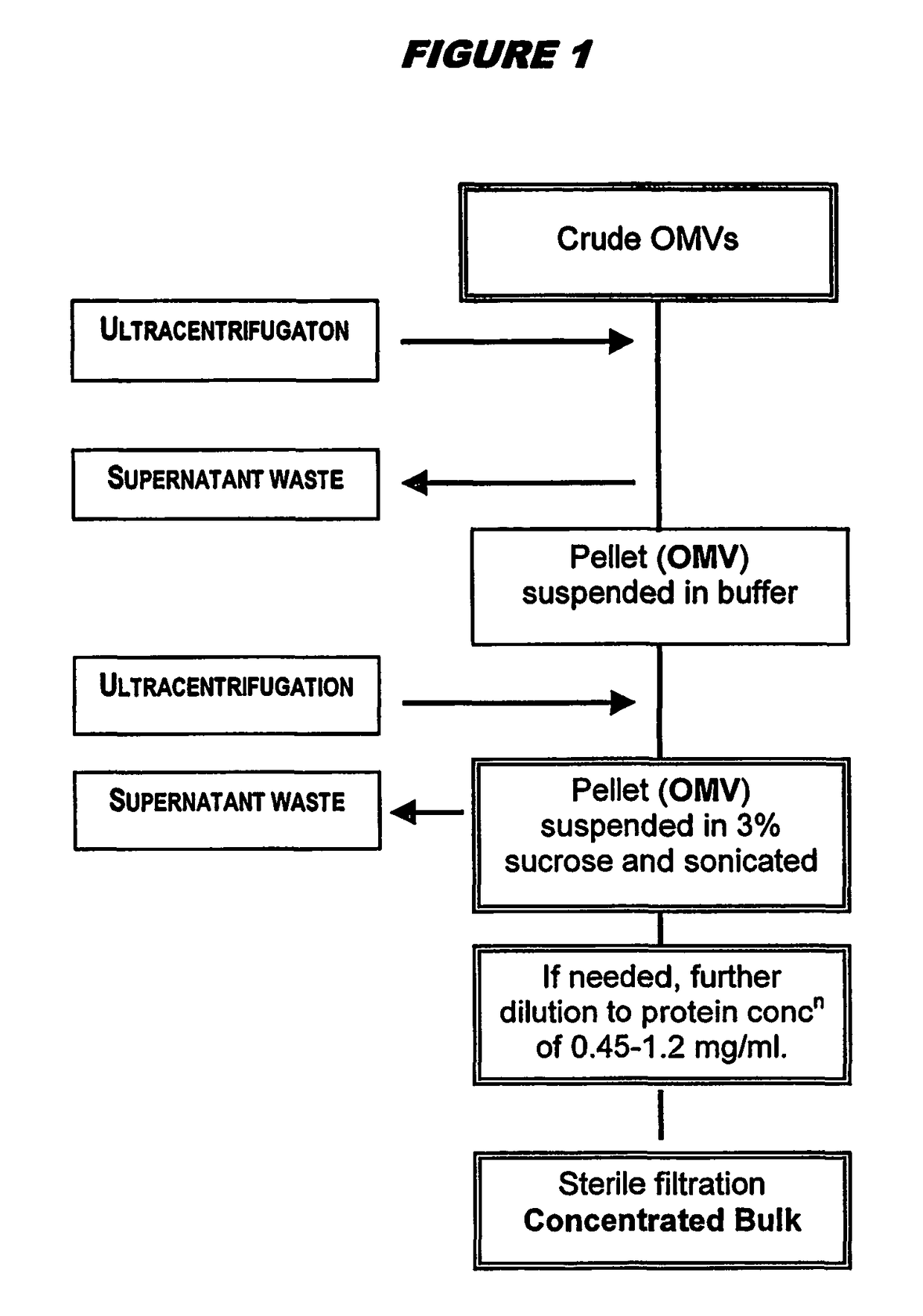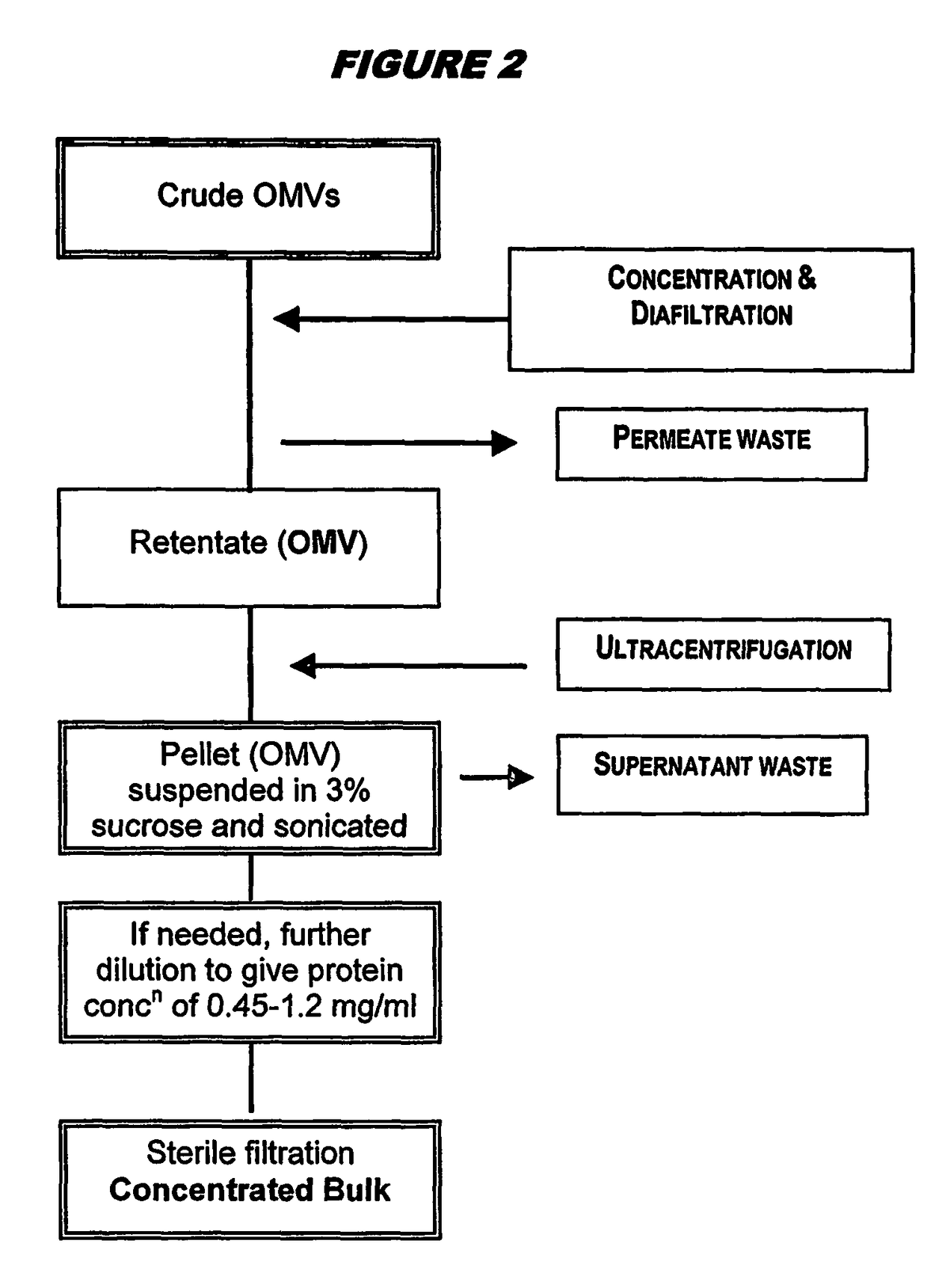Ultrafiltration for preparing outer membrane vesicles
a technology of outer membrane and ultrafiltration, which is applied in the field of ultrafiltration for preparing outer membrane vesicles, can solve the problem of limited strain
- Summary
- Abstract
- Description
- Claims
- Application Information
AI Technical Summary
Benefits of technology
Problems solved by technology
Method used
Image
Examples
example 1
OMVs from Meningococcal Serogroup B (Norwegian Strain)
[0101]N. meningitidis serogroup B (strain 44 / 76, from Norway) was cultured on eight “selective medium for Meningococci” plates at 35° C. in 5% CO2 / air atmosphere for 24 hours. Cell were harvested into 2 tubes with 12 ml Frantz' medium. Contents of tubes were added to 2×500 ml flasks containing Frantz' medium (150 ml) and grown with shaking for 12 hours to obtain the correct growth for transferring into 2×5000 ml flasks containing Frantz' medium (1500 ml). The flasks were grown with shaking for a further 12 hours to yield the inoculum. One flask was added to a Chemap fermentor with 300 L capacity, containing 110 L of pre-sterilised Frantz' medium and sterile-filtered dialysed yeast extract. The pH after inoculation was 7.1, maintained at 7.0 with 3N NaOH. A surface aeration fermentation was performed, controlling the amount of air O2 and stirrer applied, and cultivating for 10 hours at 35° C. Growth was terminated at an OD590nm of...
example 2
OMVs from Meningococcal Serogroup B (New Zealand Strain)
[0112]N. meningitidis serogroup B (strain NZ 98 / 254, from New Zealand) was cultured as before, except that: (a) Catlin medium was used in place of Frantz' medium; (b) the initial 150 ml cultures were grown to a level ready for transferring into a Chemap fermentor with 300 L capacity, containing 120 L of pre-sterilized medium; (c) growth in the Chemap fermentor was for 12 hours; (d) growth was terminated at OD590nm of 5.90.
[0113]Transfer from the fermentor was as before, except that concentration was performed until 5 L volume.
[0114]Concentration was performed as before.
[0115]pH was adjusted as before, except that: (a) the final pH was 8.6; (b) the amount of 0.1 M Tris-HCl buffer added was 6 L.
[0116]Inactivation / extraction was as before, except: (a) 600 ml of the Tris-HCl buffer was added; (b) the volume of extracted suspension was 19.5 L.
[0117]Preparation of crude OMVs was as before, except: (a) centrifuge tubes were 1000 ml vo...
example 3
OMVs from Meningococcal Serogroup B (New Zealand Strain)
[0123]Crude OMVs were prepared from the 98 / 254 strain as described above. The pH was adjusted to between 7.5 and 9.0 (typically between 8.3 and 8.5) with buffer, and then concentrated up to 20 liters by ultrafiltration for between 3.5 and 4.5 hours using Polysulphone Millipore Pellicon 2 cassettes with a surface area of 3 m2. The concentrate material was diafiltered against 7 volumes of a solution containing Tris-EDTA, 1% DOC and 20% sucrose (‘buffer B’), and then with 3 volumes of ‘buffer B1’ (same as ‘buffer B’ but with only 0.5% DOC). The retentate was concentrated again up to 4 liters and collected. The ultrafiltration system was washed with buffer B1. The retentate was then washed, and OMVs (retentate+washes) were stored at 2-8° C. The bioburden in the final material was zero, and endotoxin content was <0.05 UI / ml. The process showed excellent lot-to-lot consistency.
[0124]The stored material was centrifuged in a Beckman Co...
PUM
| Property | Measurement | Unit |
|---|---|---|
| pore-size | aaaaa | aaaaa |
| time | aaaaa | aaaaa |
| pore size | aaaaa | aaaaa |
Abstract
Description
Claims
Application Information
 Login to View More
Login to View More - R&D
- Intellectual Property
- Life Sciences
- Materials
- Tech Scout
- Unparalleled Data Quality
- Higher Quality Content
- 60% Fewer Hallucinations
Browse by: Latest US Patents, China's latest patents, Technical Efficacy Thesaurus, Application Domain, Technology Topic, Popular Technical Reports.
© 2025 PatSnap. All rights reserved.Legal|Privacy policy|Modern Slavery Act Transparency Statement|Sitemap|About US| Contact US: help@patsnap.com


